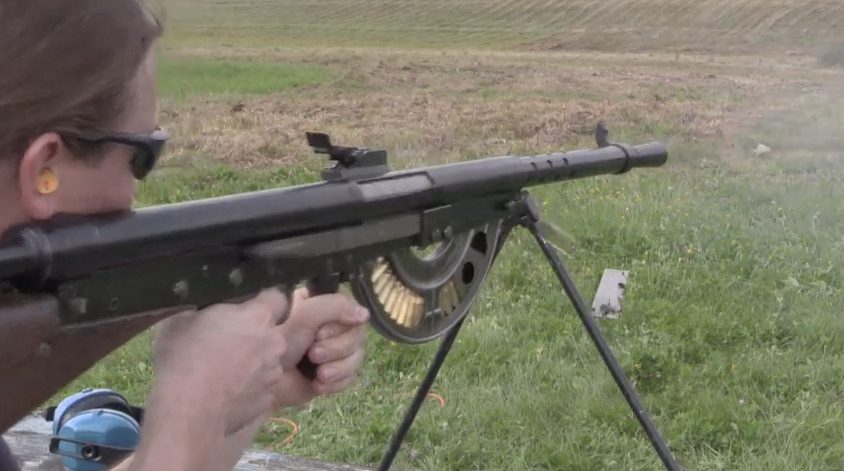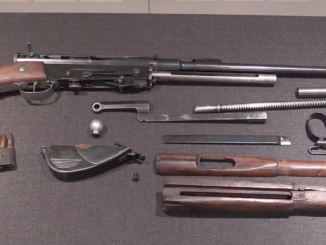Did you know that the French Army issued more than 80,000 semiautomatic rifles during WWI? They had been experimenting with a great many semiauto designs before the war, and in 1916 finalized a design for a rotating bolt, long stroke gas piston rifle (with more than few similarities to the M1 Garand, actually) which would see field service beginning in 1917. An improved version was put into production in 1918, but too late to see any significant combat use.
The RSC 1917 was not a perfect design, but it was good enough and the only true semiauto infantry rifle fielded by anyone in significant numbers during the war.




Yet again, a potentially great design marred by manufacturers who took too many shortcuts. The bolt was susceptible to dirt ingestion and the original charger was a non-standard design which made logistics heck for the soldiers. At least the basic frame was one already in production. And no, the French were not cheese-eating surrendering monkeys. Sadly for the enemy counterpart, the Mondragon, production costs and shipping fees from Switzerland killed it along with incompatibility with mud…
It was a wartime product put on production on short notice using the 8mm Lebel the granddaddy of all the modern bullets with is also the worse bullet for automatic (or in this case semiauto) fire, 800000 been made is an enormous feature, nobody did it in WWI, Mondragon rifles were luxury products like the Madsen compared with the Chauchat.
So much potential for after WWI but the sheer number of 8mm Lebels and Berthiers made during the war and the peace dividend killed anything until they slowly return to work with the new 7.5mm bullet, but it was to late in 39/40.
The real winning combo for french infantry in 1917/18 was that: http://rosalielebel75.franceserv.com/armesportatives/fusilier-chauchat-grenadier.jpg
The Chauchat + the Viven-Bessières rifle grenade launcher.
I mean 80000 made, sorry.
I don’t want to be malicious but you confuse term bullet with cartridge. Bullet is part of cartridge.
So far I know 8x50R Lebel itself was shortcut – it was not designed from scratch but by necking down, which give it heavily tapered shape (compare for example 20-round magazine for Chauchat machine gun with AK magazine for 30 rounds – first is 180 degrees, when second less than 90 degrees).
Not malice, bad english from me ;D Thanks.
A full page about it :
http://armesfrancaises.free.fr/FSA%201917.html
I like everything about this rifle. It is cleverly and meticulously designed. I’d say even ahead of Steyr self-loading rifle of the period.
I would discount general note regarding “let down by manufacture” as some suggest, because the war required quantity on demand. Perhaps the point of question I’d have is interface of operating rod with stock – there is opportunity for added resistance.
Thanks for showing the source
Very cool.
A magazine that tips its hat to Krag, Jorgensen and Mannlicher!
And a bolt which uses multiple rows of lugs to compensate for the limited lug bearing area seen in the likes of garands, which use only slight bolt rotation for locking.
Superficially, it looks better engineered for mass production than a garand too, even if that tapered ejection port does look like a concession to a committee member.
I remember reading they were appreciated, but also criticized for their sensibility to dust and dirt.
It is important to note that it was prone to jammings, but many charged the harsh conditions of the front instead of the rifle itself.
As said by Ian, this rifle was given to “good shooters” (litteraly : the orders of that time was to give the rifle to the “bons tireurs”, litteraly the “good shooters”). In the words of that time, these “good shooters” were rather the mens that known how to use effectively a rifle and not simply accurate shooters, thus people that were able to keep their rifle clean and in working conditions.
These soldiers would find the RSC 1917 well made, effective and countable. A soldier among others would fine it sensible to dirt and not so countable.
It is similar to the M60 complex : many soldiers say it is heavy, cumbersome, difficult to maintain and prone to jammings and parts loses. Navy Seals just say it’s a wonderful gun. Why ? Because Navy Seals are more able to operate and maintain a gun the good way.
sorry I replied to the wrong post…
This style of magazine was also used on the PTRS-41 Anti-tank rifle. For obviously flawed design reasons (namely the insert-one-way five-round charger), the Simonov-made PTRS did not really replace the single-shot PTRD.
PTRD as a single-shot weapon was obviously cheaper (less time need to production).
Name – quantity of whole production – when:
PTRD – 281111 examples – from 22 September 1941 to December 1944
PTRS – 190615 examples – from November 1941 to 1945
Notice that PTRS was produced later than PTRD, so no “insert-one-way five-round charger” was no reason.
Does anyone have any reports of what the troops thought about it? Did it give any tactical advantage in actual use?
Meunier 7mm semi-auto rifles had the reputation to work better.
My understanding is that they were well liked, but I have not found any firsthand reports or accounts.
I remember reading they were appreciated, but also criticized for their sensibility to dust and dirt.
It is important to note that it was prone to jammings, but many charged the harsh conditions of the front instead of the rifle itself.
As said by Ian, this rifle was given to “good shooters” (litteraly : the orders of that time was to give the rifle to the “bons tireurs”, litteraly the “good shooters”). In the words of that time, these “good shooters” were rather the mens that known how to use effectively a rifle and not simply accurate shooters, thus people that were able to keep their rifle clean and in working conditions.
These soldiers would find the RSC 1917 well made, effective and countable. A soldier among others would fine it sensible to dirt and not so countable.
It is similar to the M60 complex : many soldiers say it is heavy, cumbersome, difficult to maintain and prone to jammings and parts loses. Navy Seals just say it’s a wonderful gun. Why ? Because Navy Seals are more able to operate and maintain a gun the good way.
I’m hallucinating, i do’nt understand why the french ”return” to the bolt action with the MAS 36
If I am not mistaken – France just developed weapon for not riflemen (artillerymen, drivers, etc) first i.e. MAS-36 and later for riflemen i.e. MAS-40 which was self-loading rifle, but don’t manage to put into wide service before Fall Gelb.
MAS-40 later evolved to finally become MAS-49/56 which proved to be successful.
Notice that in case of Berthier short version (Berthier Mle 1890) was developed before long version (Berthier Mle 1902)
Remember also that France was developing stuff while suffering from the Great Depression! No money, no toys!
Comparison of the parts of an M1 Garand with an RSC 1917 :
https://mountainpreparedness.wordpress.com/2012/11/19/the-forgotten-french-history-of-the-all-american-m1-garand-rifle/
Oui. M1 Garand avant la lettre… Good points.
Okay, time to try again with asking questions and getting answers for my troubles.
Given two-dozen RSC 1917s and some gun-smith’s tools and materials, what would you do to it apart from adding the obvious dust cover or rechambering the rifles for a better cartridge?
1. Change the feed system to accommodate detachable magazines
2. Improve the gas port
3. Redesign the bolt and receiver to eliminate dirt ingestion
4. Chop away most of the stock except for the gas tube, issue to snipers
5. Add fire-selector mode to safety catch for full-auto, add bipod and top-mounted magazine Madsen LMG style
6. Toss the rifles into the river, knife German troops in their sleep and take all their stuff…
7. Do whatever!!!
This is totally voluntary, by the way!
Cherndog
The only major problem with the RSC in either the 1917 or 1918 versions was the gas port’s tendency to accumulate carbon fouling, which could have been alleviated the same was we did it with the M-16 in Vietnam; switch to a cleaner-burning powder. Dupont IMR as used in U.S. Army standard .30-06 ammunition would probably have worked well enough in terms of pressure curve, etc.
The rimmed 8mm Lebel round really isn’t that big a handicap, assuming a properly-designed feed system. The Bren used the rimmed 0.303in round, and few people ever complained about its reliability.
BTW, intact M1917s and M1918s are rare today, nor because of being scrapped, but because postwar most were sent out to the various French colonies and were worn out in service. And a lot of those which were had their gas ports welded shut, thereby converting them essentially to straight-pull manual bolt-actions.
Contrary to Hollywood, the Legion Etrangere’ had a lot more “bolt-action” RSCs than they ever did Lebels between the wars. After V-E Day, of course, they mostly changed over to Kar98Ks that had become “excess to requirements” of the Wehrmacht. BTW, postwar, their standard officers’ sidearm was the P.38 in 9 x 19mm, too, not the M1892 8mm revolver.
cheers
eon
Dry firing will break the firing pin. These rifles suffer from parts breakage. Many were converted to straight pull when Balle N was made standard. The M1917s in inventory were used hard and very worn. Balls N was much hotter than the older Balls D and required modifications to the chamber,rear sight and in the case of the M1917 & M1918 function tested. It was simpler to make the rifles manually operated rather than try to restandardize springs for semiautomatic firing.
I would really like to see a firing version of this rifle? Any chance Ian?
With a little luck, I will be able to do some shooting with an RSC 1918 before too long…
Not if I don’t beat you to it. I have a line on a mle 17.
Ian, it would be fascinating if you could get your hands on one of the “volley fire” (ie, fully automatic) French conversions of the Winchester 1907 and do a video.
There were also the experimental Woodhull “auto carbines” entered in the U.S. Army trials of 1941 that ended in the adoption of the Winchester-designed .30 M1 Carbine;
https://www.forgottenweapons.com/light-rifle-program/woodhull-carbine/
The Woodhull prototypes were modified from Winchester M1907 carbines in .30 and .351, and M1910s in .401 WSL.
Most if not all of both were modified to selective-fire with 20-round magazines.
cheers
eon
Out of subject but I wish Ian could do something on the 1866 winchester Maxim converted to semi auto.There is a drawing of it on page 106 of the 1973 edition of Smiths small arms of rhe world Apparently the conversions was used on turkish winchester 44’s in or about 1883